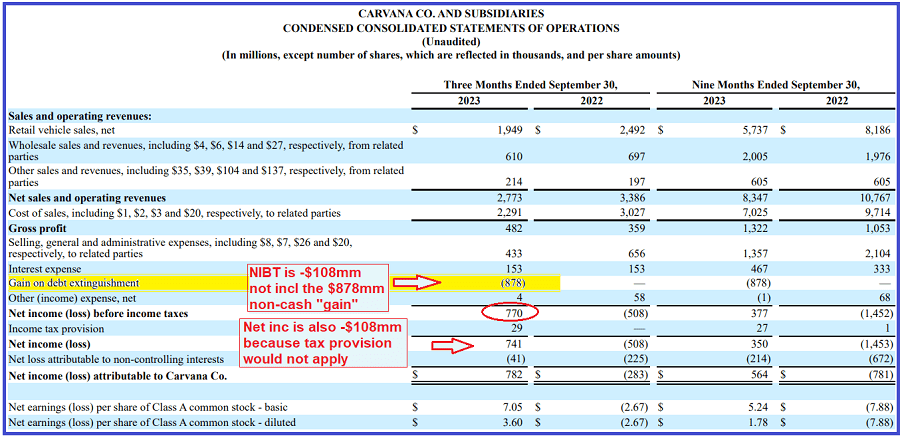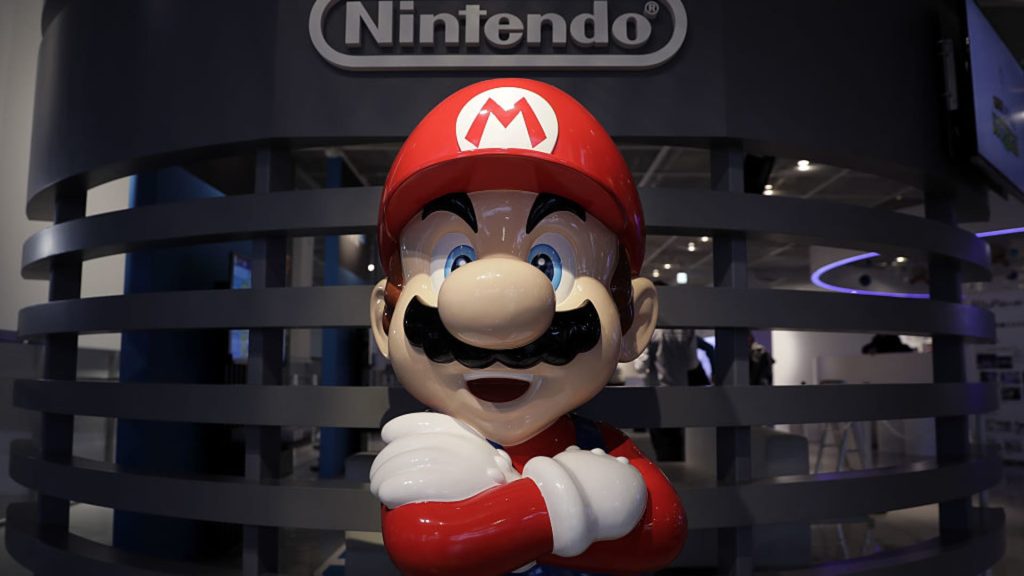The following analysis is from my latest issue of the Short Seller’s Journal.
Carvana (NYSE:CVNA – $31.96) – CVNA reported its quarterly numbers Thursday after the close. Of course, the headline report announced that the Company beat the Street.
But as is always the case with CVNA, a look under the hood reveals both heavy use of accounting gimmicks and the continued deterioration of CVNA’s business model.
This includes a 52% plunge in the number of vehicles listed on the website at the end of the quarter and a 28.6% decline in average monthly unique visitors to the website vs. Q3 2022.
Revenues declined 18% YoY and 6.6% from Q2. Retail vehicle unit sales plunged 21% YoY for Q3. YTD through nine months revenues are down 22.4%. While the Company was boasting about a big jump in the gross profit per vehicle sold, a significant contributor to the reduced cost of sales was the result of the Company playing games with the auto loan volume it originates and sells.
CVNA reported $5.95k GPU (gross profit per unit), an increase of $2.45k GPU vs. Q3 2022. But of this $2.45k, $1.8k (or 73.5%) is attributable to the gain on loan sales that resulted from an unusually large reduction in auto loans held for sale.
In all probability, this source of GPU benefit will be non-recurring or greatly reduced going forward. In addition, it admitted in the footnotes that it took a non-recurring accounting “allowance,” meaning a non-cash credit applied to the cost of sales.
In reality, CVNA lost $108 million for the quarter:

Moreover, this gain is fictitious. It provides zero economic benefit to the Company other than two years of reduced cash interest expense.
However, as I detailed in the July 23rd issue of SSJ after the transaction was announced, after two years of the PIK feature, the amount of debt will be back to where it was before the exchange and the rate of interest on the debt will be higher:
CVNA also announced a debt restructuring that will involve exchanging $5.6 billion in debt that matures between October 2025 and May 2030 for $4.3 billion of new notes that mature in December 2028 through June 2031.
The new notes have a PIK feature for up to two years (pay-in-kind, meaning the Company can pay the interest expense for up to two years in more bonds rather than cash).
However, the PIK feature comes at a steep cost. The existing debt carries an average coupon of roughly 8.9%. One tranche of the new notes has a PIK coupon rate of 12% and 9% cash thereafter, while a second note tranche carries a PIK coupon of 13% and 11% cash thereafter and the third new tranche has a 14% PIK and 9% cash thereafter.
The weighted average cost of the PIK debt payments is roughly 13.1%. If CVNA chooses to PIK the notes for the first two years, after two years there will be roughly $5.6 billion in notes outstanding ($4.3 billion compounded 13.18% over two years). The same amount of debt outstanding before the debt restructuring!
The reason CVNA is able to claim that it produced positive net income is because the Company reduced the total outstanding amount of bonds via the debt exchange along with the issuance of $452 million in stock.
Because of this, GAAP entitles the company to recognize a one-time non-cash gain of $878 million, which represents the amount of the discount to par value of bonds that were eliminated from the debt exchange.
Ironically, the one-time “gain” from the extinguishment of debt will be erased after two years. The problem with the GAAP treatment of this matter is that CVNA gets the optical benefit of the “gain” but will not have to reverse that “gain” despite the fact that the debt level will be back to where it was before the exchange.
One skeleton that will pop out of the closet for CVNA is its liquidity. Cash at the end of Q3 was $616 million, down slightly from the end of Q2. But this included the $453 million from the sale of shares during Q3.
$213 million of the cash provided by operations in Q3 was the result of inventory drawdown (i.e. selling more inventory than was replaced). CVNA can’t continue with this rapid inventory reduction much longer or it risks the loss of potential sales.
Another $500 million of the cash provided from operations came from selling more car loans than originated. In most quarters, the amount of proceeds from the sale of loans is roughly equivalent to the amount originated.
As with the inventory drawdown, this is not a sustainable source of cash. The amount of finance receivables held for sale declined to $650 million by the end of Q3 vs. $1.098 billion at the end of Q2 and $1.334 billion at the end of 2022.
There may be a little more “juice” to squeeze out of the sale of finance receivables in excess of originations, but it becomes more difficult as unit sales continue to decline. Also, the credit quality of some percentage of these loans is likely to be too low to dump into ABS bond trusts.

I wanted to show the comparison of the Q2 and Q3 asset side of the balance sheet because it’s a good visualization of what I mean when I say that CVNA’s business model is deteriorating in size.
CVNA’s cash provided from operations was $599 million. But $713 million is attributable to the extraordinary reduction in finance receivables and inventory. This means that, on balance, the cash provided from operations outside of those two items was negative $114 million.
As mentioned earlier, the overall scale of CVNA’s business model is contracting. At some point in the next couple of quarters, CVNA will need to raise cash. It is authorized to sell up to $547 million more worth of shares via at-the-market offerings. This means that the Company can sell shares at any time without announcing it to the market until after the shares are sold.
Carvana is insanely overvalued on its own but also relative to AutoNation (AN) and CarMax (CMX) (note: I think AN and KMX are also good shorts).
It’s tough to do a full comparison of the respective valuation metrics because both AN and KMX generate operating and net income while Carvana generates neither. But CVNA trades at a price/sales ratio of 0.32x. KMX trades at a P/S of 0.39x and AN trades at a P/S of 0.22x.
Carvana is much smaller in terms of revenues, which means its business risks are higher. And of course there’s the debt load, which substantially increases CVNA’s riskiness as an investment.
The amount of debt CVNA has outstanding and the cost of that debt is obscenely higher than the amount of debt, and the cost to service that debt, that is carried by KMX and AN relative to the size of their revenues, profitability and total assets. As such, CVNA should trade with a P/S that is lower than the P/S’s of KMX and AN.
Applying AutoNation’s P/S ratio of 0.22 to CVNA’s trailing twelve-month revenues of $11.18 billion results in an implied market cap of $2.46 billion, or roughly $1 billion lower than the current market cap.
That translates into an implied price per share of $22.85. But that’s just a starting point. CVNA’s revenues are quickly trending lower and will for the foreseeable future as household finances become increasingly strained, and the economy continues to atrophy.
In addition, based on CVNA’s current level of cash flow generation and likely further reduced cash flow from operations, at some point, the Company will be unable to service its debt. The bondholders kicked the can down the road with the last debt exchange.
Given the continued deterioration in CVNA’s operations, it is likely that the bondholders will not tolerate another deferment of bankruptcy while the assets depreciate in value.
In a strict bankruptcy restructuring scenario, CVNA’s equity is worthless, though the court would likely toss warrants to the shareholders. In a strict liquidation scenario, CVNA’s equity is completely worthless.

CVNA, which is heavily shorted (38% of the float was short at the beginning of November), experienced a sharp bounce along with the stock market on Thursday and Friday.
I am also certain that there was some momentum-based price-chasing as well as panic short covering on Friday in response to CVNA’s headline “beat.”
Unless the market rally continues, I plan to press my short positions in CVNA over the next few weeks. Ultimately, I believe CVNA will trade under $5 within the next 12 months.
Original Post
Editor’s Note: The summary bullets for this article were chosen by Seeking Alpha editors.
Read the full article here







